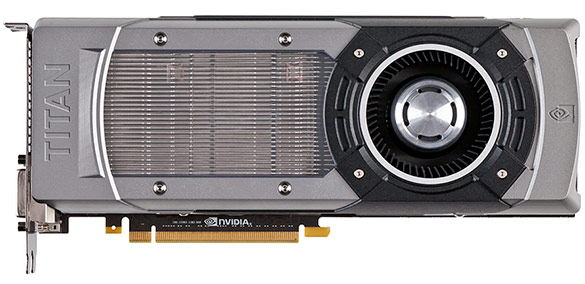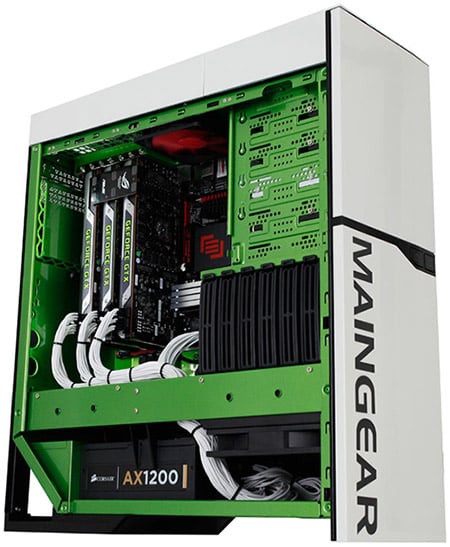A couple of days ago, we showed you the new NVIDIA GeForce GTX Titan
in all its glory—almost. While we were able to reveal the card itself,
discuss its new features and specifications, and talk about some of the
new systems it will be powering, we weren’t able to post any performance
data. Fortunately, that all changes today. We’ve been able to test
NVIDIA’s GeForce GTX
Titan in a number of different configurations, including SLI and in a
multi-monitor setup, and have the goods for you here today. And yes,
we’ve got some Crysis 3 action on tap as well.
If you haven’t already done so, we suggest checking out our initial preview of the GeForce GTX Titan. In our original piece, we outline the card’s specifications and cover its new features, like GPU Boost 2.0 and display overclocking, so we won’t be covering them again here. We do have lots of performance data though, including some GPGPU tests, and some overclocked scores too.
If you haven’t already done so, we suggest checking out our initial preview of the GeForce GTX Titan. In our original piece, we outline the card’s specifications and cover its new features, like GPU Boost 2.0 and display overclocking, so we won’t be covering them again here. We do have lots of performance data though, including some GPGPU tests, and some overclocked scores too.
 The GK110-Based NVIDIA GeForce GTX Titan
The GK110-Based NVIDIA GeForce GTX Titan
|
| Graphics Processing Clusters | 5 |
| Streaming Multiprocessors | 14 |
| CUDA Cores (single precision) | 2688 |
| CUDA Cores (double precision) | 896 |
| Texture Units | 224 |
| ROP Units | 48 |
| Base Clock | 836 MHz |
| Boost Clock | 876 MHz |
| Memory Clock (Data rate) | 6008 MHz |
| L2 Cache Size | 1536K |
| Total Video Memory | 6144MB GDDR5 |
| Memory Interface | 384-bit |
| Total Memory Bandwidth | 288.4 GB/s |
| Texture Filtering Rate (Bilinear) | 187.5 GigaTexels/sec |
| Fabrication Process | 28 nm |
| Transistor Count | 7.1 Billion |
| Connectors | 2 x Dual-Link DVI 1 x HDMI 1 x DisplayPort |
| Form Factor | Dual Slot |
| Power Connectors | One 8-pin and one 6-pin |
| Recommended Power Supply | 600 Watts |
| Thermal Design Power (TDP) | 250 Watts |
| Thermal Threshold | 95°C |
The GeForce GTX Titan’s specifications
portend to the card’s immense horsepower. Not only is the GK110 at the
heart of the GTX Titan twice the size of the GK104 used in the GeForce
GTX 600 series, but it offers some new features as well, and it’s paired
to a gigantic 6GB frame buffer. Yes, the GeForce GTX Titan’s TDP is lower than NVIDIA’s current flagship GeForce GTX 690 and the Titan is quieter too.
 The Maingear SHIFT Super Stock with 3-Way GTX Titan SLI. PCs Don't Get Sexier Than This!
The Maingear SHIFT Super Stock with 3-Way GTX Titan SLI. PCs Don't Get Sexier Than This!
According to NVIDIA, “GeForce GTX TITAN was built to power the world’s fastest gaming PCs.
From massively powerful 3-way SLI gaming supercomputers to super-fast
and elegant small form factor rigs.” And that’s a big part of the
Titan’s story. As you’ll see in the pages ahead, the card is extremely
fast. But it doesn’t supplant the GeForce GTX 690. What it does do,
however, is allow NVIDIA and its system partners—like Maingear—to offer
new ultra powerful gaming PCs and quiet, small form factor rigs with
much higher performance than they could before.
We’ve got a couple of a systems in house already that we’ll be showing you soon enough. For now though, we’re sure many of you are wondering just how well the GeForce GTX Titan performs. So without further delay, here are the benchmarks you’ve been itching to see…
We’ve got a couple of a systems in house already that we’ll be showing you soon enough. For now though, we’re sure many of you are wondering just how well the GeForce GTX Titan performs. So without further delay, here are the benchmarks you’ve been itching to see…
How We Configured Our Test Systems: We tested the graphics cards in this article on an Asus P9X79 Deluxe motherboard powered by a Core i7-3960X
six-core processor and 16GB of G.SKILL DDR3-1866 RAM. The first thing
we did when configuring the test system was enter the system UEFI and
set all values to their "high performance" default settings and disable
any integrated peripherals that wouldn't be put to use. The memory's
X.M.P. profile was enabled to ensure better-than-stock performance and
the hard drive was then formatted and Windows 7 Ultimate x64 was
installed. When the installation was complete, we fully updated the OS
and installed the latest DirectX redist along with all of the drivers,
games, and benchmark tools necessary to complete our tests.


The GeForce GTX Titan crushes the Radeon HD 7970 GHz Edition and GeForce GTX 680 in this latest version of Unigine's Heaven benchmark, outpacing both cards by about 57%. The dual-GPU powered GeForce GTX 690, however, pull ahead of the Titan by a decent margin.


Futuremark's latest edition of 3DMark shows the new GeForce GTX Titan dominating the single-GPU powered Radeon HD 7970 GHz and GeForce GTX 680. The dual-GPU powered GeForce GTX 690 pulls ahead of Titan, however, mostly due to a large advantage in performance in 3DMark's Game Test 1.
|
| Hardware Used: Intel Core i7-3960X (3.3GHz, Six-Core) Asus P9X79 Deluxe (Intel X79 Express) Radeon HD 7970 GHz Edition x 2 GeForce GTX 680 x 2 GeForce GTX 690 GeForce GTX Titan x 3 16GB GSKILL DDR3-1866 Western Digital Raptor 150GB Integrated Audio Integrated Network |
Relevant Software: Windows 7 Ultimate x64 DirectX April 2011 Redist AMD Catalyst v13.2 Beta 6 NVIDIA GeForce Drivers v314.07 / v314.09 Benchmarks Used: Unigine Heaven v4 3DMark "Fire Strike" Batman: Arkham City Hitman: Absolution Alien vs. Predator Metro 2033 Sleeping Dogs Crysis 3 |
|
 Unigine Heaven v4.0
Unigine Heaven v4.0 |
Unigine's Heaven Benchmark v4.0 is built around the Unigine game engine. Unigine is a cross-platform, real-time 3D engine, with support for DirectX 9, DirectX 10, DirectX 11 and OpenGL. The Heaven benchmark--when run in DX11 mode--also makes comprehensive use of tessellation technology and advanced SSAO (screen-space ambient occlusion). It also features volumetric cumulonimbus clouds generated by a physically accurate algorithm and a dynamic sky with light scattering. |


The GeForce GTX Titan crushes the Radeon HD 7970 GHz Edition and GeForce GTX 680 in this latest version of Unigine's Heaven benchmark, outpacing both cards by about 57%. The dual-GPU powered GeForce GTX 690, however, pull ahead of the Titan by a decent margin.
 Futuremark 3DMark Fire Strike |
Fire Strike has two benchmark modes: Normal mode runs in 1920x1080, while Extreme mode targets 2560x1440. GPU target frame buffer utilization for normal mode is 1GB and the benchmark uses tessellation, ambient occlusion, volume illumination, and a medium-quality depth of field filter. The more taxing Extreme mode targets 1.5GB of frame buffer memory and increases detail levels across the board. Extreme mode is explicitly designed for CrossFire / SLI systems. GT 1 focuses on geometry and illumination, with over 100 shadow casting spot lights, 140 non-shadow casting point lights, and 3.9 million vertices calculated for tessellation per frame. Only 80 million pixels are processed per frame. GT2 emphasizes particles and GPU simulations. Tessellation volume is reduced to 2.6 million vertices, but the number of pixels processed per frame rises to 170 million. |


Futuremark's latest edition of 3DMark shows the new GeForce GTX Titan dominating the single-GPU powered Radeon HD 7970 GHz and GeForce GTX 680. The dual-GPU powered GeForce GTX 690 pulls ahead of Titan, however, mostly due to a large advantage in performance in 3DMark's Game Test 1.
|
 Crysis 3 |
Crysis
3, which is powered by Crytek’s proprietary CryENGINE 3, technology is
the third installment in this popular franchise. Crysis 3 is the sequel
to 2011’s Crysis 2 and follows Prophet as he returns to New York a few
years after the events of Crysis 2. Like previous games in the
franchise, Crysis 3 has impressive visuals that can tax even the most
powerful PC’s when cranked up to their maximum values. We tested this
game at various resolutions with all in-game graphics options set to Very High, with 4X MSAA and 16X anisotropic filtering enabled and motion blur set to high.
|


The dual-GPU powered GeForce GTX 690 remains the fastest card overall in Crysis 3, outpacing the new GeForce GTX Titan at both resolutions. Titan, however, clearly outpaces the other single-GPU powered cards which couldn't put up playable frame rates in this game, with the very high image quality settings that we used for testing. Back the image quality down a bit, however, and of course the game is playable for all cards.
We mentioned in our preview article that the GeForce GTX Titan includes a full 64 Double Precision CUDA Cores per SMX versus 192 Single Precision CUDA Cores. But, by default, the GeForce GTX Titan runs its DP cores at 1/8th their full clock speed, since they generally don't benefit gamers Since each SMX has one third the number of DP cores vs. SP cores, double precision operations run at 1/24 the SP rate, which is similar to GeForce GTX 680.
 NVIDIA's Drivers Give Users The Ability To Unlock Full DP Mode on Titan
NVIDIA's Drivers Give Users The Ability To Unlock Full DP Mode on TitanNVIDIA, however, gives users the ability to enable full speed DP in the drive control panel. In order to unlock full performance DP you must open the NVIDIA Control Panel, navigate to “Manage 3D Settings” and under the Global Settings tab find the option titled “CUDA – Double Precision”. Select it, then tick the GeForce GTX Titan checkbox to enable full speed DP. Then click OK and apply the settings. The CUDA – Double Precision listing should then change from “None” to “GeForce GTX Titan”. When full speed DP is enabled though, the GeForce GTX Titan's GPU operates at lower-than-stock frequencies, so this option should be disabled unless you're a GPU-accelerated application that will benefit from it.
To test the GeForce GTX Titan's GPU compute capabilities, we ran a couple of GPGPU benchmarks with SiSoft SANDRA and Computemark. We tested all of the cards represented here with SANDRA's GP (GPU/CPU/APU) Processing benchmark, using the OpenCL GP Processor option and have the aggregate and native double-shader scores for you reported below.
|

We tested the GeForce GTX Titan with an without full DP enabled here. Even with full DP disabled, the Titan is clearly faster than the GeForce GTX 680, due to the increased number of cores available in the GPU. Titan still trails the Radeon HD 7970, however. With full DP enabled though, the Titan's performance jumps up considerably and outpaces all of the other cards we tested.
|


The Computemark benchmark doesn't benefit from the Titan's full speed DP mode, so we left it disabled for these tests. Regardless, Computemark leverages all of the cores available in the GK110 for its simulations quite well, and as such, the GeForce GTX Titan clearly outpaces all of the other cards here.
EVGA's Precision X GPU tweaking utility, which is designed to work with Titan.
Overclocking a Kepler-based GeForce GTX series graphics card requires a bit more tweaking then previous-gen products, due to all of the new options available and the complexities associated with GPU Boost. Sometimes, you’ll find that increasing a particular voltage or frequency may appear to function properly, when in fact performance decreases due to errors or throttling. You may also find that the actual GPU Boost clock may travel above or below the designated offset value when the power and/or temperature targets are also increased.
 EVGA's Precision X Tweaking Utility Running On The GeForce GTX Titan
EVGA's Precision X Tweaking Utility Running On The GeForce GTX TitanWe did a few things when experimenting with overclocked speeds on Titan. First we tried the most basic option available--we simply changed the temperature target from the default 80'C and increased it to 90'C to see what kind of impact it would have on performance. Then, to push things much further, we increased the power and temperature targets to 105% and 92'C, respectively, and also increased the GPU and Memory clock offsets and ran a few tests.
|


Interestingly enough, increasing the temperature target to 90'C resulted in a small increase in performance, not only because the GPU was able to run at higher boost frequencies for longer periods, but the boost frequency actually increased as well. Although the default GPU boost clock on Titan is 876MHz, we observed frequencies as high as 993MHz. For our more aggressive overclocking tests, we saw a much higher GPU boost frequency of almost 1.1GHz, and when coupled with higher memory clocks, the performance increases were significant. Hitman in particular showed a 12% increase in performance. Keep in mind, these clocks were possible without manually tweaking the Titan's voltages. With further experimentation, we're certain the GeForce GTX Titan can hit even higher clocks than what we've shown here.
The moral of the story: Even with 7.1B transistors under the hood, the GeForce GTX Titan has plenty of frequency headroom left for overclockers.
|

Despite offering significantly better performance, the GeForce GTX Titan consumed only slightly more power than the Radeon HD 7970 GHz Edition while under load. Versus the other GeForce GTX cards, the Titan's power consumption falls right in line with expectations based on its performance--it uses more power than a GeForce GTX 680, but less than the dual GK104-powered GeForce GTX 690.

We've included this temperature data to essentially show the GeForce GTX Titan's idle temperature because reporting the max temp under load is pointless due to GPU Boost 2.0. Because of Titan's GPU Boost 2.0 features, it will run up to the maximum temperature target while under load and throttle voltages and fan speed accordingly to maintain that target temperature. Because the default temperature target is 80'C, the Titan peaked at 80'C under load. Set the temp target to 75'C and that's how high its GPU temperature will go.
Having a hard temperature target with the GeForce GTX Titan is interesting because it means cards that are better cooled--either through liquid cooling or when installed in a high-performance chassis--should offer somewhat better performance. The cooler a GeForce GTX Titan runs, the longer it will be able to maintain maximum GPU Boost frequencies, which will ultimately improve performance.
In terms of acoustics, the GeForce GTX Titan is simply awesome. It is easily the quietest high-end graphics card we have ever tested. Period. End of story. In real world conditions, the GeForce GTX Titan is somewhat quieter under load than a GTX 680 and is much quieter than a Radeon HD 7970.
Performance Summary: The GeForce GTX Titan is easily the fastest single-GPU powered graphics card we have ever tested, bar none. In every benchmark or game we threw at it, regardless of resolution, the GeForce GTX Titan clearly outpaced the Radeon HD 7970 GHz Edition and the GeForce GTX 680, sometimes by margins over 50%. The GeForce GTX Titan couldn’t quite keep pace with the dual-GPU powered GeForce GTX 690, but the Titan is in the same league. The GeForce GTX Titans acoustics are also best of class. Considering the immense horsepower offered by Titan, the card is just plain quiet. Power consumption is also in-line with expectations.
 The GeForce GTX Titan is the fastest single-GPU powered card available.
The GeForce GTX Titan is the fastest single-GPU powered card available.As we mentioned in our initial preview, the GeForce GTX Titan should be available immediately from many of NVIDIA’s key system partners, with limited retail availability to follow. The price for this beast: $999, which is right in line with the GeForce GTX 690. There’s no denying there’s a steep premium for a card like the GeForce GTX Titan, but enthusiasts that want the best of the best have always had to pay up. While the GeForce GTX Titan’s performance isn’t quite as high as the GTX 690 on its own, the card does set a new benchmark for ultra high-performance when configured in tri-SLI and in a single-card configuration the GeForce GTX Titan can fit into smaller form factors where the GeForce GTX 690 could not. While the GeForce GTX Titan may not knock the GTX 690 from its position atop the 3D graphics food chain, it does allow NVIDIA and its partners to offer new flagship systems gaming systems and more powerful small form factor systems, which should appeal gamers and systems builders alike.
We wish the GeForce GTX Titan was more affordable so that more gamers could experience the power of this beast, but for now the card will remain a luxury for those that can afford it. The GeForce GTX Titan’s relatively high price doesn’t detract from its pure awesomeness though. Yeah, it would be great if it was more affordable, but 7.1 billion transistors, a 6GB frame buffer, best of class performance, and some hot new features make the GeForce GTX Titan one of the most exciting products we’ve tested in a quite a while.
And if you haven’t had enough GeForce GTX Titan coverage, stay tune to HH—we’ve got a 3-way SLI Maingear SHIFT in house and a SFF Titan-enabled small form factor system from AVA Direct on the test bench as well.

|
|
Sumber : http://hothardware.com

Tidak ada komentar:
Posting Komentar